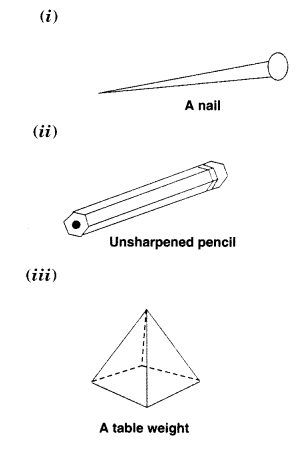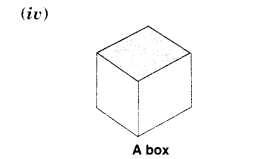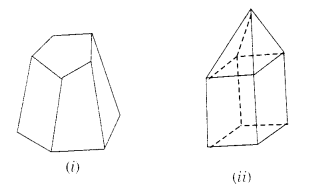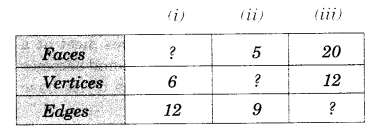NCERT Solutions for Class 8 Maths Chapter 10 Visualising Solid Shapes Ex 10.3 are part of NCERT Solutions for Class 8 Maths. Here we have given NCERT Solutions for Class 8 Maths Chapter 10 Visualising Solid Shapes Ex 10.3.
| Board | CBSE |
| Textbook | NCERT |
| Class | Class 8 |
| Subject | Maths |
| Chapter | Chapter 10 |
| Chapter Name | Visualising Solid Shapes |
| Exercise | Ex 10.3 |
| Number of Questions Solved | 8 |
| Category | NCERT Solutions |
NCERT Solutions for Class 8 Maths Chapter 10 Visualising Solid Shapes Ex 10.3
Question 1.
Can a polyhedron have for its faces
(i) 3 triangles?
(ii) 4 triangles?
(iii) a square and four triangles?
Solution.
(i) No
(ii) Yes
(iii) Yes
Question 2.
Is it possible to have a polyhedron with any given number of faces? (Hint: Think of a pyramid).
Solution.
Possible, only if the number of faces is greater than or equal to 4.
Question 3.
Which are prisms among the following?


Solution.
We know that a prism is a polyhedron whose base and top faces are congruent and parallel and other (lateral) faces are parallelograms in shape. So, only (ii) and (iv) are prisms.
Question 4.
(i) How are prisms and cylinders alike?
(ii) How are pyramids and cones alike?
Solution.
(i) The prisms and cylinder, both, have their base and top faces as congruent and parallel to each other. Also, a prism becomes a cylinder as the number of sides of its base becomes larger and larger.
(ii) The pyramids and cones are alike in the sense that their lateral faces meet at a point (called vertex). Also, a pyramid becomes a cone as the number of sides of its base becomes larger and larger.
Question 5.
Is a square prism same as a cube ? Explain.
Solution.
No; not always as it can be a cuboid also.
Question 6.
Verify Euler’s formula for these solids

Solution.
(i)
F = 7
V= 10
E = 15
F + V = 7 + 10 = 17
E + 2 = 15 + 2 = 17
So, F + V = E + 2
Hence, Euler’s Formula is verified,
(ii)
F = 9
V = 9
E = 16
F + V = 9 + 9 = 18
E + 2 = 16 + 2 = 18
So, F + V = E + 2
Hence, Euler’s Formula is verified
Question 7.
Using Euler’s formula find the unknown.

Solution.
(i)
F + V = E + 2
⇒ F + 6 = 12 + 2
⇒ F + 6 = 14
⇒ F = 14 – 6 = 8
(ii)
F + V = E + 2
⇒ 5 + V = 9 + 2
⇒ 5 + V = 11
⇒ V= 11-5 = 6
(iii)
F + V = E + 2
⇒ 20 + 12 = E + 2
⇒ 32 = E + 2
⇒ E = 32 – 2
⇒ E = 30
Question 8.
Can a polyhedron have 10 faces, 20 edges, and 15 vertices?
Solution.
Here F = 10
E = 20
V= 15
So, F + V = 10 + 15 = 25
E + 2 = 20 + 2 = 22
∵ F + V ≠ E + 2
∴ Such a polyhedron is not possible.
We hope the NCERT Solutions for Class 8 Maths Chapter 10 Visualising Solid Shapes Ex 10.3 help you. If you have any query regarding NCERT Solutions for Class 8 Maths Chapter 10 Visualising Solid Shapes Ex 10.3, drop a comment below and we will get back to you at the earliest.